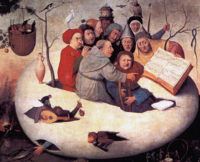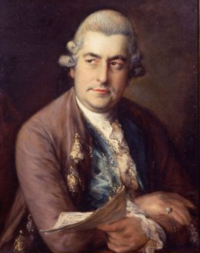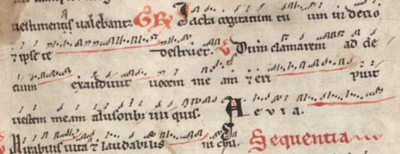Template:DRM images: Difference between revisions
| Line 18: | Line 18: | ||
This image database of medieval and renaissance manuscripts based at the University of California, Berkeley, includes holdings from many US libraries, with extensive folio-specific information about each source. | This image database of medieval and renaissance manuscripts based at the University of California, Berkeley, includes holdings from many US libraries, with extensive folio-specific information about each source. | ||
[[File:HBosch.png|200px|thumb|left|<small>Follower of Hieronymous Bosch: Concert in the Egg, <i>c</i>. 1561.</small>]] | [[File:HBosch.png|200px|thumb|left|<small>Follower of Hieronymous Bosch: Concert in the Egg, <i>c</i>. 1561.</small>]] | ||
Revision as of 00:48, 29 November 2020
Beethoven (Life and Works)
Website: Beethoven (Life and Works)
This gallery in Europeana takes a liberal view of its subjects in offering everything from a picture of an earhorn to depictions of his patrons, neighborhood associated with his life, and the final draft of the ninth symphony.
The Digital Image Archive of Medieval Music (DIAMM)
Website: Digital Image Archive of Medieval Music (DIAMM)
Originally a site for viewing images of rare manuscripts at various levels of resolution, DIAMM is increasingly an umbrella site for diverse projects in medieval music. The core textual database is organized by source location. Registered users may add their own comments about individual works. List and faceted search capabilities are currently being added. DIAMM now (2017) includes online registration. Some of the value in DIAMM comes from its extensive canvas of what exists (almost 50,000 item listings to date). roughly 2,000 have images, some of very high quality. Digital restoration has always been a key provision of the DIAMM mandate.
Digital Scriptorium
Website: Digital Scriptorium
This image database of medieval and renaissance manuscripts based at the University of California, Berkeley, includes holdings from many US libraries, with extensive folio-specific information about each source.

Early Music Sources: Iconography Database
Website: Early Music Sources: Iconograph Database
Early Music Sources, a growing collection of sources, images, instructional materials, and videos, provides ready access to images showing early musicians in performance.
Emblems
Emblematica Online
Website: Emblematica Online
This umbrella project serves a growing number of library-based projects, which are here cited individually. Emblem books are rich resources for those interested in decoding visual information in early printed materials. The collective site currently (April 2014) lists 636 emblem books. Searches by title, text, and image are supported. There are two component parts. (1) The Herzog August Bibliothek (HAB) Emblem Books and (2) the University of Illinois Emblem Books.
The first makes available 636 emblems books, principally from the 17th and 18th centuries. It represents only a tiny fraction of the rich holdings of the Herzog August Bibliothek in Wolffenbüttel, which is particularly rich in seventeenth-century materials. August the Younger developed a three-tiered description system still in use today. Two noted figures--G. W. Leibniz (1691-1716) and G. E. Lessing (1770-1781) were later librarians. German materials are prevalent in the Illinois collection (as well as the German one).
Additional digitized emblem books from Duke University, the Getty Library, Glasgow University, and the University of Utrecht are in course of being uploaded. Each has a separate search page.
French Emblems at Glasgow
Website: French Emblems at Glasgow
This site hosts 27 browsable emblem books associated with 16th-century France. Eack book is linked to an alphabetical listing by author that enables rapid exploration. Some sources are bilaterally in Latin. A smaller collection of Italian emblem books is also held. This collection includes several important iconographical works by Andrea Alciati, whose influenced was substantial in France.
Iconoteca (Portraits of Musicians)
Website: Iconoteca

The collection of painted portraits of eighteenth-century composers and musicians that was begun by the Franciscan priest Padre Gio. Battista Martini (1706-84) attracted a much larger and more diverse repository of lithographs, photographs, and other graphical impressions of musicians and composers over time. These resources, numbering above 1,500 items, form a widely used source for printed books and concert programs. Martini also preserved more than 6,000 letters to and from musicians and others dealing with musical topics. The letters are also available online here, with corresponding numbers taken from Anne Schobelen's catalogue (New York, 1979). Through the letters it is often possible to date portraits accurately.
Index of Christian Art
Website: Index of Christian Art
One hundred twenty thousand (120,000) images from public and private collections in the English-speaking world plus additional indices; roughly 100,000 are available to the public via fee-based institutional subscriptions. Holdings from early centuries of Christianity to 1550.
Joconde (Musical Objects and Images)
Website: Joconde (Musical Objects and Images)
Joconde, the French national database of museum holdings, includes generous search tools for musical holdings. (Enter "musique" in the search bar near the bottom of the frame.) Listings range from the widely seen to the obscure. Additional background can be found at this listing.
Joseph Muller Collection of Music and Other Portraits
Website: Joseph Muller Collection of Music and Other Portraits
This collection of 6,422 portraits of musicians and composers, residing within the New York Public Library, was amassed by the private collector Joseph Muller (1877-1939). It is well known to those seeking illustrations for books and articles on musical subjects. Images date from the 16th to the early 20th century and include engravings, lithographs, and drawings. The collection also includes some portraits of political, literary, and intellectual figures. Prospective users will find that full citations for each item are given in several formats.
Manuscriptorium
Website: Manuscriptorium
The National Library of the Czech Republic started this site to make available digital images of historical materials in its own collections and those of collaborators. its emphasis is on manuscripts, early prints, incubulae, and the like. In addition it is building research tools to support such endeavors. Manuscriptorium constitutes a subcategory of Europeana. Many of its holdings are conveyed in obsolete scripts, for which the site offers a useful character-identification lexicon called Gaiji. Its obviously later sheet-music collection has also been popular.
Medieval Legends with Music
The Carmina Burana
Website: The Carmina Burana

The 11th- to 12th-century collection of poetry and dramatic texts is rich in illustration and many of its texts contain cheironomic notation. Although found in a Benedictine abbey in Bavaria in 1803 and housed today in the Bavarian State Library, its origins point to compilation along the southern fringe of Austria, particularly Carinthia. Its Goliard sources come from Spain, the British Isles, France, and elsewhere in Europe. The texts are predominantly in medieval Latin, with some examples of Middle High German and Provençal. Musical settings of individual pieces are numerous following Carl Orff's 1936 presentation of 24 of the pieces (roughly one-tenth of the collection).
Songs of the Nibelungen
Website: Das Nibelungenlied
These poetic texts, considered to date from before 1280, display settings of the legends that inspired Richard Wagner. As is characteristic of those resources preserved for posterity in this period, the script is very carefully prepared, the vellum on which it is preserved obviously sturdy. Each Lied is illuminated by a carmine letter. The texts mention Sifriden (Siegfried), Prvnhilde (Brunhilde), Gvnther (Gunther), and others. The illustration shows the first three stanzas of "Wie Gvnther Sifriden zvo der hohzit bat" (No. 12 of 39). Later portions of the source contain religious songs (Klage).
Medieval Manuscripts Online
Website: Medieval Manuscripts Online
This list of links gives a broad international overview of the raw materials of medieval study and the heterogenity of these materials. The web interfaces are similarly varied and access to the sources is often indirect. Those who work on medieval subjects will find a lot of pick through here. There is inevitably some redundancy with several specifically musical resources listed above.
Prometheus
Website: Prometheus Image Database
The Prometheus Image Database is a collection of 88 separate repositories, all of which have made reproductions that are out-of-copyright freely available at sizes up to 800 x 600. (An institutional or individual sign-up with required for downloading.) Currently more than 1.5 million images relating to cultural history are viewable. The images are predominantly associated with German, French, Italian, and Dutch subjects in art and archeology, past and present media, and the history of science and technology.
PRoMS (The Production of Reading of Musical Sources)
Website: [http://proms.ac.uk/ PRoMS (The Production and Reading of Musical Sources)
PRoMS, a UK collaboration in which six institutions collaborate, is focused on the physical details of polyphonic sources originating between 1435 and 1600. It builds on resources made available by DIAMM (UK), Manuscriptorium (CZ), and holding libraries in various countries. The sources are scattered throughout Western and Central Europe (or Amiens to Zwickau in the alphabetical listing).
Watermark Databases
Watermark examination provides a fundamental (analogue) method of sorting and ordering materials that are undated or lack a provenance. They are especially useful for clustering manuscripts by paper type. The combination of digital photography and tools for photographic editing can be combined with extensive existing research on paper-makers to shed new light on musical sources. The sites listed here include watermarks associated specifically with music manuscripts.
The Bernstein Project
Website: The Bernstein Project
The Bernstein Project is a portal currently offering 220,000 watermarks. Forming part of the EU [http://www.memoryofpaper.eu:8080/BernsteinPortal/appl_start.disp Memory of Paper] project, the website provides links to dozens of other websites with information and images of watermarks used from the middle ages onward. Relationships to music manuscripts must usually be determined by the user, but see WZIS below.
WILC: Watermarks in Incuabula printed in the Low Countries
Website: Watermarks in Incuabula printed in the Low Countries (WILC
Many early printing presses operated in the Low Countries. This database lists more than 2,000 of them. It contains large numbers of beta radiographs from incunabla and forms part of the Bernstein project listed separately.
WZIS: Watermark Information System
Website: Wasserzeichen Informationssystem Deutschland

The WZIS is a project of extensive scope. Its goal is to compile a graphical database of watermarks used throughout Europe. The project is based at the Landesarchiv of Baden-Württemberg. A graphical watermark lexicon called Piccard is under development at the Stuttgart Hauptstaatsarchiv. Related lexicons of makers and mills have also been developed. A textual search form is also available. Although we are aware of many other digital collections of watermarks, this one stands out for its tight coupling with music manuscripts, particularly in the large collections of the Berlin and Dresden state libraries, which are in turn linked to the RISM OPAC.